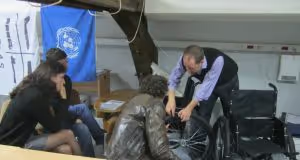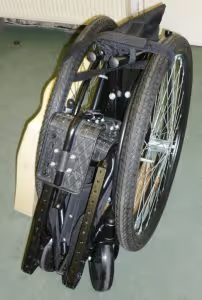Design Decisions with Handicap International

Sarah Sheldon- Programme Coordinator, Motivation The meetings last week with our partner in this project Handicap International were really productive. Handicap International has 30 years of experience of working with disabled people in emergency relief so are ideal partners for us in this project. We took two different prototypes of the emergency wheelchair to discuss with them and were able to agree on key design points.

Discussing the prototypes with Handicap International Our starting point was to finalise a statement which defines the scope of this emergency wheelchair. Although we had already agreed the purpose of the wheelchair, this statement will guide field workers in the contexts in which they can use the wheelchair. This wheelchair is for temporary users. It is also suitable for permanent users on a temporary basis until a fuller service assessment is carried out. This fuller service assessment needs to be carried out within one year, or less, of the wheelchair being delivered.Assessing Adjustability Generally full adjustability in a wheelchair is required – i.e. adjustable height footrests, seat length and backrest height, along with a choice of seat widths to ensure the service staff are able to fit the wheelchair correctly to the user, to allow maximum function and give postural support. However where a natural disaster, such as an earthquake, has occurred, the largest number of people who need wheelchairs are trauma patients. This group of wheelchair users do not need such a full clinical service, as they only require a wheelchair temporarily for mobility. To account for this difference in user demographics, we will be trialling chairs with a single backrest height which will help keep the final cost of the wheelchair low.

Container Calculations One decision that needed to be made was how much of the wheelchair would be assembled in the factory and how much in the field. Field workers generally want products that are ready to be used straight from the box with little preparation, but when fully assembled only 250 boxed wheelchairs would fit in a shipping container. We agreed that the wheelchairs will be semi assembled with field workers fixing the wheels, footrests and push handles to the wheelchairs in the field. This means we will be able to fit the wheelchairs and components in smaller boxes and be able to fit 400 in a container, reducing the shipping costs for each chair by over a third. Next stepsOver the next month we will be working with the producer in China to continue to develop the prototypes and negotiate costs. Once we have the next set of prototypes we will be able to begin strength, durability and safety trials before teaming up with Handicap International again to prepare for initial field trials.
Stay updated
Sign up for our newsletter to receive regular updates on resources, news, and insights like this. Don’t miss out on important information that can help you stay informed and engaged.
Related articles
.png)


Explore Elrha
Learn more about our mission, the organisations we support, and the resources we provide to drive research and innovation in humanitarian response.